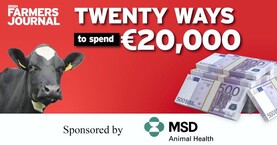One of the interesting debates at the Irish Farmers Journal Open Day at the Tullamore Farm this week was around the quality of beef we produce and the markets available for it.
Farmers that have bred quality stock for decades bemoan the fact that factories aren’t supportive of real quality animals with price cuts often applied when carcases are over a certain weight or age.
On the other hand, when these highest quality animals are sold as weanlings, they will regularly top mart prices and figures of €4/kg were mentioned during the discussion.
The thinking is that when these cattle are worth top price as weanlings, what changes when they go into the factory and become beef carcases.
The blunt answer is the market in which the highest share of our beef is sold.
Top of the range weanlings are usually for the live export market with Italian buyers particularly interested in this type of stock.
However, the harsh reality is that Irish factories don’t seem to have outlets for these elite cattle when processed into the range of beef cuts that comes from the carcase.
The main outlets for Irish beef that is processed in the factories is a combination of retail or supermarket trade for prime cuts and burger chains and wider food service outlets for the lower value forequarter cuts that usually finish up as burgers or mince.
Specifications
The problem with having supermarkets as a major customer is that they have a limited size specification for the highest value steak meat cuts.
In an investigation some time ago, the Farmers Journal along with Bord Bia selected three top grading animals and examined how these fit into the supermarket specification for steak cuts.
As picture 1 shows, these carcases are all top quality U grading cattle.
The one on the right was a U=4= steer weighing 466.7kg, the middle one was a U-3+ grade weighting 404.2 kg while the one on the left of the picture was a U-3+ heifer weighing 324.6kg.
These were all superb carcases with an exceptionally high meat yield. However, there was a problem as shown in pictures 2, 3 and 4.

467kg carcase doesn't fit gauge that measures steak size for retail packs.

404kg carcase also doesn't fit gauge.

325kg carcase fits the gauge perfectly though with nothing to spare.
When supplying a supermarket order, a key issue is having striploin steaks of more or less equal size that fit comfortably into retail packs.
However in this case the pictures show that the steaks from the two heavier cattle don’t fit into the frame that is designed for measuring beef loins to establish if they fit the retail pack.
If they don’t fit the frame they don’t qualify for the supermarket trade and are sold in secondary wholesale markets for a lower value.
Factories with supermarket customers simply pay less for these cattle unless they have continental markets where heavier weights and larger steaks are accepted.
The fact that a quality U grading carcase can be considered not suitable for any market appears like a contradiction.
However, everything in the retail trade is geared towards having uniformity across all products so that they can present a fridge full of retail packs of steaks at a standard price.
It seems counterintuitive that there is a better chance of an O grading heifer meeting this specification than a U grading steer. This frustrates farmers, particularly farmers that keep high quality continental bred stock.
As livestock sales prices show there is indeed a market for a number of these as weanlings but there is an upper limit and the vast majority of cattle going into factories are from what would be considered lesser quality and increasingly of dairy herd origin.
If these meet the specification, factories will show their preference for these by the price they pay. For farmers, it is a case of finding the best market for what you produce to make sure best value is secured.
This is particularly important if breeding larger cattle; make sure there is a market outlet that is prepared to pay a value that reflects their cost of production.
One of the interesting debates at the Irish Farmers Journal Open Day at the Tullamore Farm this week was around the quality of beef we produce and the markets available for it.
Farmers that have bred quality stock for decades bemoan the fact that factories aren’t supportive of real quality animals with price cuts often applied when carcases are over a certain weight or age.
On the other hand, when these highest quality animals are sold as weanlings, they will regularly top mart prices and figures of €4/kg were mentioned during the discussion.
The thinking is that when these cattle are worth top price as weanlings, what changes when they go into the factory and become beef carcases.
The blunt answer is the market in which the highest share of our beef is sold.
Top of the range weanlings are usually for the live export market with Italian buyers particularly interested in this type of stock.
However, the harsh reality is that Irish factories don’t seem to have outlets for these elite cattle when processed into the range of beef cuts that comes from the carcase.
The main outlets for Irish beef that is processed in the factories is a combination of retail or supermarket trade for prime cuts and burger chains and wider food service outlets for the lower value forequarter cuts that usually finish up as burgers or mince.
Specifications
The problem with having supermarkets as a major customer is that they have a limited size specification for the highest value steak meat cuts.
In an investigation some time ago, the Farmers Journal along with Bord Bia selected three top grading animals and examined how these fit into the supermarket specification for steak cuts.
As picture 1 shows, these carcases are all top quality U grading cattle.
The one on the right was a U=4= steer weighing 466.7kg, the middle one was a U-3+ grade weighting 404.2 kg while the one on the left of the picture was a U-3+ heifer weighing 324.6kg.
These were all superb carcases with an exceptionally high meat yield. However, there was a problem as shown in pictures 2, 3 and 4.

467kg carcase doesn't fit gauge that measures steak size for retail packs.

404kg carcase also doesn't fit gauge.

325kg carcase fits the gauge perfectly though with nothing to spare.
When supplying a supermarket order, a key issue is having striploin steaks of more or less equal size that fit comfortably into retail packs.
However in this case the pictures show that the steaks from the two heavier cattle don’t fit into the frame that is designed for measuring beef loins to establish if they fit the retail pack.
If they don’t fit the frame they don’t qualify for the supermarket trade and are sold in secondary wholesale markets for a lower value.
Factories with supermarket customers simply pay less for these cattle unless they have continental markets where heavier weights and larger steaks are accepted.
The fact that a quality U grading carcase can be considered not suitable for any market appears like a contradiction.
However, everything in the retail trade is geared towards having uniformity across all products so that they can present a fridge full of retail packs of steaks at a standard price.
It seems counterintuitive that there is a better chance of an O grading heifer meeting this specification than a U grading steer. This frustrates farmers, particularly farmers that keep high quality continental bred stock.
As livestock sales prices show there is indeed a market for a number of these as weanlings but there is an upper limit and the vast majority of cattle going into factories are from what would be considered lesser quality and increasingly of dairy herd origin.
If these meet the specification, factories will show their preference for these by the price they pay. For farmers, it is a case of finding the best market for what you produce to make sure best value is secured.
This is particularly important if breeding larger cattle; make sure there is a market outlet that is prepared to pay a value that reflects their cost of production.









 This is a subscriber-only article
This is a subscriber-only article










SHARING OPTIONS: